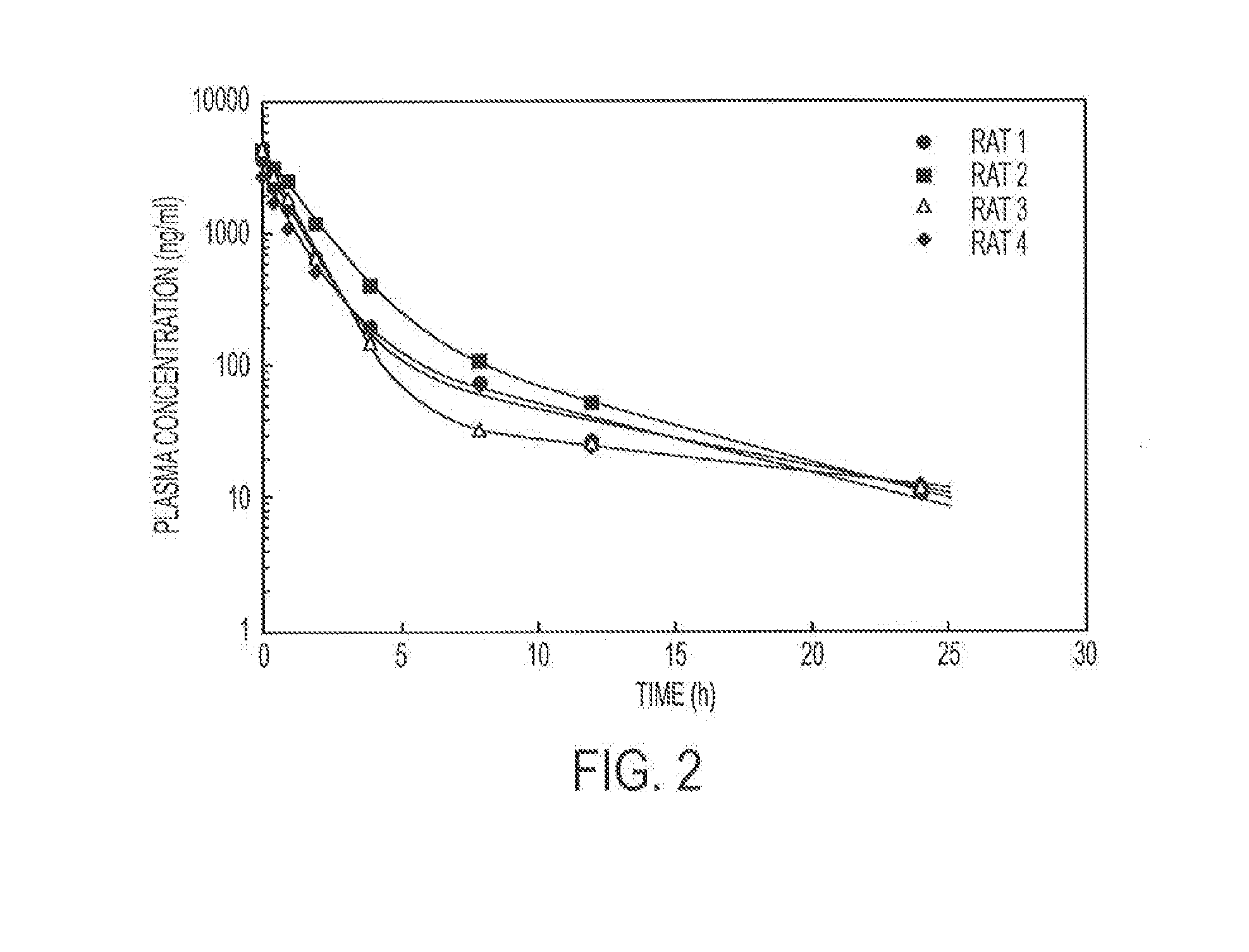Controlled release hydrogels
a technology of hydrogels and hydrogels, which is applied in the field of formulations, can solve the problems of unsuitability of hydrogels as controlled drug delivery devices, and achieve the effect of reducing the risk of side effects
- Summary
- Abstract
- Description
- Claims
- Application Information
AI Technical Summary
Benefits of technology
Problems solved by technology
Method used
Image
Examples
example 1
[0091]In Example 1, a hydrogel formulation in accordance with the present invention was prepared as follows:
A. Synthesis of Thiol Protected 2-Mercaptosuccinic Acid.
[0092]One equivalent of 2-mercaptosuccinic acid and three equivalents of triphenylmethyl (trityl) chloride were dissolved in degassed dimethyl formamide (DMF) in a flask assembled with an argon balloon. The reaction was performed at room temperature (25° C.) with magnetic stirring overnight and monitored by thin layer chromatography. The reaction mixture was extracted in dichloromethane (DCM) and loaded onto a silica gel column for purification. The eluted fractions containing trityl-protected mercaptosuccinic acid were collected and dried using rotary vacuum evaporation (Buchi RE111 Rotavapor, Brinkman Instruments Inc. Westbury, N.Y.) followed by high vacuum (Welch W oil pump, Series 5, Welch Rietschle Thomas, Skokie, Ill.). The product was characterized using mass spectroscopy.
B. Synthesis of the Thiol-Containing PEG Co...
example 2
[0096]In Example 2, TPT-liposomes were prepared by active loading. “Active loading” of drugs in liposomes typically includes the generation of Transmembrane pH gradients in which the liposomal interior pH is such that once the unionized drug passively diffuses into the liposome it becomes charged and thus trapped in the liposome interior.
A. Transmembrane pH Gradient
[0097]TPT liposomes were prepared by dissolving DSPC (3.8 μmoles), cholesterol (25 μmoles) and egg phosphatidyl choline (9.2 μmoles) in chloroform. The organic solvent was completely removed by rotary evaporation and high vacuum forming a thin lipid film. The lipid film was hydrated with 4 mL PBS (0.1 M, pH 8.0) for 90 minutes with constant agitation while maintaining a temperature of 60° C. The liposome suspension was sonicated for 60 minutes to reduce the size of the liposomes. The external pH was reduced to 2 units with HCl (1.0 M) generating a transmembrane gradient in which the internal pH of the liposomes was 8.0 an...
example 3
Release of Free TPT and TPT-Liposomes from the Hydrogel
[0099]Hydrogels containing 4% (w / v) copolymer were prepared as described in Example 1. Free TPT (238 μg / gel) or TPT liposomes (238 μg / gel) were added to the copolymer solution and physically entrapped in the hydrogel upon the addition of the vinylsulfone crosslinker (PEGDVS). Hydrogels were either placed directly in vials containing 15 mL of release buffer (PBS 0.1 M, pH 7.4) or in dialysis bags (containing 1 mL of buffer), which were subsequently submerged in vials of PBS. At predetermined time intervals, an aliquot was removed from each vial and the concentration of TPT determined fluorometrically. To ensure that sink conditions were maintained, an equivalent volume of release buffer was replaced after sampling.
[0100]To distinguish between whether free TPT or intact TPT liposomes were released from the hydrogel, hydrogels containing TPT liposomes were either placed directly in the release buffer (total drug released) or placed...
PUM
| Property | Measurement | Unit |
|---|---|---|
| pH | aaaaa | aaaaa |
| molecular weight | aaaaa | aaaaa |
| solubility | aaaaa | aaaaa |
Abstract
Description
Claims
Application Information
 Login to View More
Login to View More - R&D
- Intellectual Property
- Life Sciences
- Materials
- Tech Scout
- Unparalleled Data Quality
- Higher Quality Content
- 60% Fewer Hallucinations
Browse by: Latest US Patents, China's latest patents, Technical Efficacy Thesaurus, Application Domain, Technology Topic, Popular Technical Reports.
© 2025 PatSnap. All rights reserved.Legal|Privacy policy|Modern Slavery Act Transparency Statement|Sitemap|About US| Contact US: help@patsnap.com



